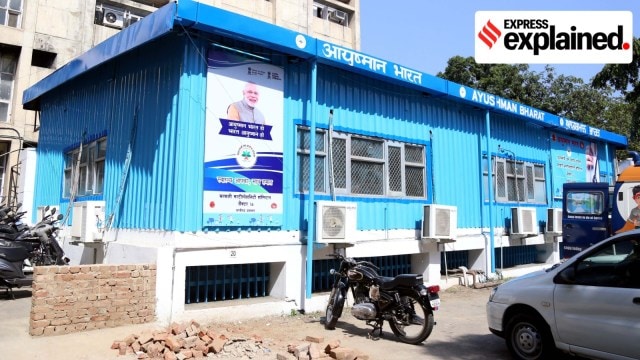Why the Centre has extended the Digital Health Incentive Scheme
Under the scheme, government and private hospitals, clinics, nursing homes, diagnostic labs, and pharmacies are paid Rs 20 for each additional record they digitise, over and above the threshold of 100 transactions a month.
 The scheme helps reimburse hospitals their expenditure on digitising their facility. This expenditure was often reported as a significant bottleneck for hospitals to move to digital health. (Express photo)
The scheme helps reimburse hospitals their expenditure on digitising their facility. This expenditure was often reported as a significant bottleneck for hospitals to move to digital health. (Express photo)The central government has given a year-long extension to the Digital Health Incentive Scheme (DHIS) meant for digitising patients’ health records and linking them with the Ayushman Bharat Digital Health Account (ABHA ID). The scheme, which was launched on January 1, 2023, will now remain in effect till June 30, 2025. The Centre has also sought details from states and union territories on the utilisation of funds received through the scheme.
Under the scheme, government and private hospitals, clinics, nursing homes, diagnostic labs, and pharmacies are paid Rs 20 for each additional record they digitise, over and above the threshold of 100 transactions a month. The scheme is applicable to both public and private hospitals and digital solution companies (DSCs) creating digital health records. Under it, each facility or digital solution company can earn incentives up to Rs 4 crores.
Why has the scheme been extended?
The scheme was launched by the National Health Authority (NHA) on January 1, 2023 to promote digital health transactions and to provide a boost to the healthcare providers for adopting digital health.
Subsequently, the NHA has come up with some relaxations like reduced transaction limits in the existing scheme in April 2023. It is meant to incentivise providers of digital health solutions such as hospital’s health management information system (HMIS) and laboratory management information system (LMIS) to make available the right software at an affordable cost
According to an update shared by the NHA on X, the scheme has been extended considering the good results it showed.
“This extension would serve to further galvanise health facilities in embracing the digital prerequisites essential for their operations,” the post read.
What impact will it have on hospitals?
The scheme helps reimburse hospitals their expenditure on digitising their facility. This expenditure was often reported as a significant bottleneck for hospitals to move to digital health.
Hospitals and clinics have to install computers and laptops, purchase an internet connection, and software (HMIS/LMIS) to go digital. A behaviour change component is also involved in moving from physical mode of working to digital. The scheme is on the lines of the incentives given for promotion of UPI.
How many hospitals and digital health companies have availed the incentive?
According to the public dashboard, 4,005 healthcare facilities, including 1,085 private and 41 DSCs which include 36 private companies have registered for the scheme. 584 health care facilities including 83 private health facilities, and 12 DSCs including 10 private companies have availed the scheme, said a senior official National Health Authority looking after the DHIS.
Around Rs 34.5 crore have been disbursed so far with Rs 24.91 crore allocated to health care facilities (Rs 24.24 crore to public facilities and Rs 66.88 lakh to private facilities) and Rs 9.59 crore to DSCs (Rs 6.34 crore to public DSCs and Rs 3.25 crore to private DSCs). Public DSCs include companies such as National Informatics Centre (NIC) and Centre for Development of Advanced Computing (C-DAC), which provide eHospital and eSushrut solutions to government hospitals.
How can it be beneficial for the patients?
DHIS equips the care providers to become digital, thereby enabling better healthcare services and more convenience for patients. By enabling digital transactions – the patient’s waiting time gets reduced. Patients will be able to scan a QR code and avail quick OPD registrations. They can also securely view, access, and share their health records with the care providers.
Without the scheme, hospitals are likely to recover the digitisation costs from the patients.
With digital records being maintained, patients are less likely to get same tests done repeatedly due to loss of records, especially in cases of migrant workers and patients travelling from one state to another.
What is an ABHA ID and what is its purpose?
ABHA ID is a unique identity for people — just like an Aadhaar ID — that allows one to store and share their medical records digitally. So far, around 64 crore ABHA IDs have been created, according to the NHA.
Once the ID is created – whenever a patient avails a healthcare service at centres linked to the digital framework – all their records are linked to it. This ID can then be used to securely store, access, and share the healthcare records, such as doctor’s prescriptions, diagnostic test results.
Photos



- 01
- 02
- 03
- 04
- 05


































